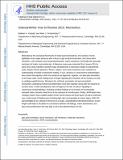| dc.contributor.author | Varady, Nathan H. | |
| dc.contributor.author | Grodzinsky, Alan J | |
| dc.date.accessioned | 2017-04-14T18:59:29Z | |
| dc.date.available | 2017-04-14T18:59:29Z | |
| dc.date.issued | 2015-12 | |
| dc.date.submitted | 2015-07 | |
| dc.identifier.issn | 1063-4584 | |
| dc.identifier.issn | 1522-9653 | |
| dc.identifier.uri | http://hdl.handle.net/1721.1/108176 | |
| dc.description.abstract | Motivated by the conceptual framework of multi-scale biomechanics, this narrative review highlights recent major advances with a focus on gait and joint kinematics, then tissue-level mechanics, cell mechanics and mechanotransduction, matrix mechanics, and finally the nanoscale mechanics of matrix macromolecules. A literature review was conducted from January 2014 to April 2015 using PubMed to identify major developments in mechanics related to osteoarthritis (OA). Studies of knee adduction, flexion, rotation, and contact mechanics have extended our understanding of medial compartment loading. In turn, advances in measurement methodologies have shown how injuries to both the meniscus and ligaments, together, can alter joint kinematics. At the tissue scale, novel findings have emerged regarding the mechanics of the meniscus as well as cartilage superficial zone. Moving to the cell level, poroelastic and poro-viscoelastic mechanisms underlying chondrocyte deformation have been reported, along with the response to osmotic stress. Further developments have emerged on the role of calcium signaling in chondrocyte mechanobiology, including exciting findings on the function of mechanically activated cation channels newly found to be expressed in chondrocytes. Finally, AFM-based nano-rheology systems have enabled studies of thin murine tissues and brush layers of matrix molecules over a wide range of loading rates including high rates corresponding to impact injury. With OA acknowledged to be a disease of the joint as an organ, understanding mechanical behavior at each length scale helps to elucidate the connections between cell biology, matrix biochemistry and tissue structure/function that may play a role in the pathomechanics of OA. | en_US |
| dc.description.sponsorship | National Institutes of Health (U.S.) (Grant AR060331) | en_US |
| dc.language.iso | en_US | |
| dc.publisher | Elsevier | en_US |
| dc.relation.isversionof | http://dx.doi.org/10.1016/j.joca.2015.08.018 | en_US |
| dc.rights | Creative Commons Attribution-NonCommercial-NoDerivs License | en_US |
| dc.rights.uri | http://creativecommons.org/licenses/by-nc-nd/4.0/ | en_US |
| dc.source | PMC | en_US |
| dc.title | Osteoarthritis year in review 2015: mechanics | en_US |
| dc.type | Article | en_US |
| dc.identifier.citation | Varady, N.H., and A.J. Grodzinsky. “Osteoarthritis Year in Review 2015: Mechanics.” Osteoarthritis and Cartilage 24, no. 1 (January 2016): 27–35. | en_US |
| dc.contributor.department | Massachusetts Institute of Technology. Department of Biological Engineering | en_US |
| dc.contributor.department | Massachusetts Institute of Technology. Department of Electrical Engineering and Computer Science | en_US |
| dc.contributor.department | Massachusetts Institute of Technology. Department of Mechanical Engineering | en_US |
| dc.contributor.mitauthor | Varady, Nathan H. | |
| dc.contributor.mitauthor | Grodzinsky, Alan J | |
| dc.relation.journal | Osteoarthritis and Cartilage | en_US |
| dc.eprint.version | Author's final manuscript | en_US |
| dc.type.uri | http://purl.org/eprint/type/JournalArticle | en_US |
| eprint.status | http://purl.org/eprint/status/PeerReviewed | en_US |
| dspace.orderedauthors | Varady, N.H.; Grodzinsky, A.J. | en_US |
| dspace.embargo.terms | N | en_US |
| dc.identifier.orcid | https://orcid.org/0000-0002-4942-3456 | |
| mit.license | PUBLISHER_CC | en_US |
| mit.metadata.status | Complete | |
